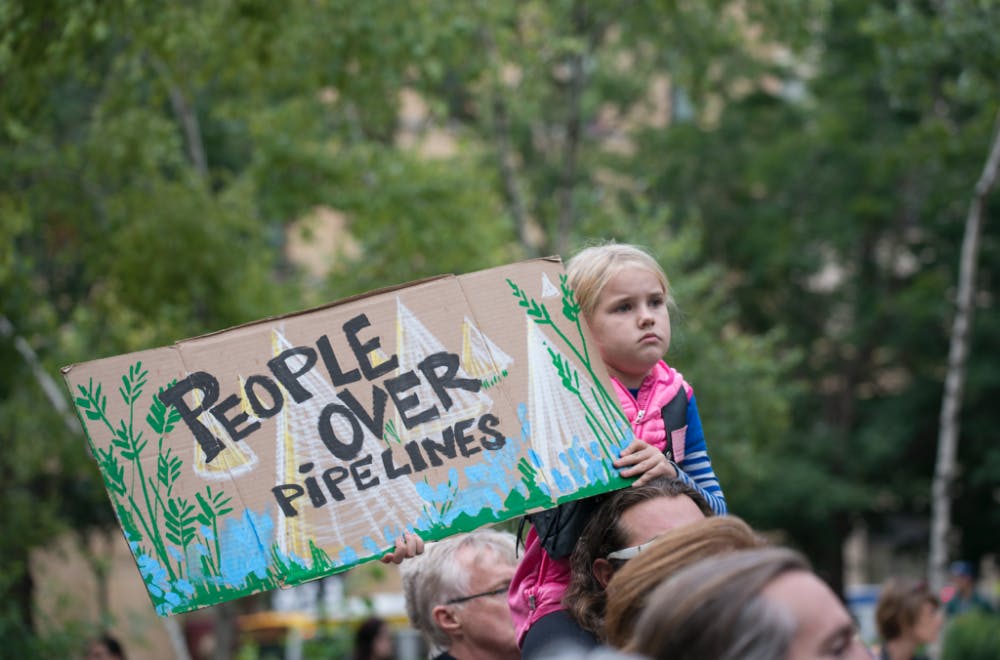There were chants, too. And prayers. Songs. Signs. Solidarity. The coming together for a cause, a movement, a purpose — for caring for one another, our well-being and our futures.
The situation at Standing Rock was one which, at its foundation, was hauntingly familiar. Although we approached it in the context of the present-day with current terminology, it was ultimately a contemporary manifestation of the same issues which have served as themes throughout American history: Native American rights and sovereignty, climate change, ecological justice, excessive use of force by police and tensions between corporations and the people whom their actions affect.
The seeds of discord were sown two years ago, when Energy Transfer Partners finalized the route of the Dakota Access Pipeline (DAPL), mapping it dangerously close to the Standing Rock Sioux Tribe reservation. The company initially considered an alternate path near Bismarck, North Dakota, but settled for the revised model due to concerns about the pipeline’s proximity to water supply sources — concerns which, in regards to the Sioux peoples, had all but evaporated.
The planned route would have run only a half-mile upstream from the reservation. Standing
Rock relies on a single water source: the Missouri River. A pipeline built under it would have risked that any leak, even a small one, would poison the water supply of over 8,000 people.
As the protestors, otherwise known as water-protectors, have been chanting for months, water is life. DAPL would have placed the Natives’ lives in jeopardy by endangering the sanctity of this vital element. They would have been dependent on the “safety” of the constructed pipeline.
Yet, as the Pipeline and Hazardous Materials Safety Administration reports, hundreds of incidents occur each year at oil and gas pipelines, with the total sum nearing 4,000 incidents since 2010. It is no wonder then that the water-protectors had little to trust in. No pipeline is truly safe.
DAPL moved from proposal to reality long ago, despite the fact that the United States Army Corps of Engineers (the federal agency responsible for approving the project) had not consulted with Standing Rock leaders. The land DAPL attempted to gain access to in order to complete the line, although not technically within the bounds of the reservation, is nonetheless full of the indigenous peoples’ heritage.
Its history, strained with struggle, attests to that. In 1868 the Treaty of Fort Laramie promised the Native people this section of land. Not a dozen years later, the government rescinded that “guarantee,” forcing the Sioux peoples to relinquish much of it. The Supreme Court ruled in 1980 that at least one area of this land was seized unjustly, as if not all of it were bathed in colonialism.
Before any decision was called, the construction crews had already bulldozed through sacred land, burial sites whose cultural significance to the Sioux peoples is of the highest caliber. DAPL did not have permission to touch that area, yet they proceeded to destroy it anyway. Given free reign, the company’s disregard for the members of Standing Rock would have allowed violations of their security and heritage.
The Corps has a duty to consult with Native peoples whenever ancestral land is concerned, regardless of its proximity to reservations. It is indigenous peoples’ right. The Sioux sued the Corps for infringing that right and protested DAPL for their right to clean water along with thousands of non-Natives who joined.
Now they have won.
After stalling for several months, the Corps, as of last week, denied DAPL the easement to construct in that one crucial point, the land beneath the Missouri River.
This one victory, this one realization of justice, cannot erase the proliferative injustices etched into history, whose weeds burgeon even now. Sacred lands have already been demolished. The U.S. is already one of the biggest contributors to man-made climate change.
Nonviolent protesters have already been brutalized by a militarized police force, simply for protecting the right to water, the right to culture and the right to a homeland.
Yet today, at least, we can say the interests of corporations have not triumphed over the rights of people. Today environmental racism has not won. Today our steady march toward ecological disaster has been challenged, if only in the slightest.
Today the echoes of history, of indigenous peoples struggling to retain basic rights — their land, their culture, their sovereignty — against an invasive, indifferent government will no longer be made to reverberate with renewed strength.
The struggle does not end here. We have put people over convenience, ease, and profit. Today we have a victory. We must continue to be vigilant, so that it does not remain the exception of today but becomes the routine of every day.


















